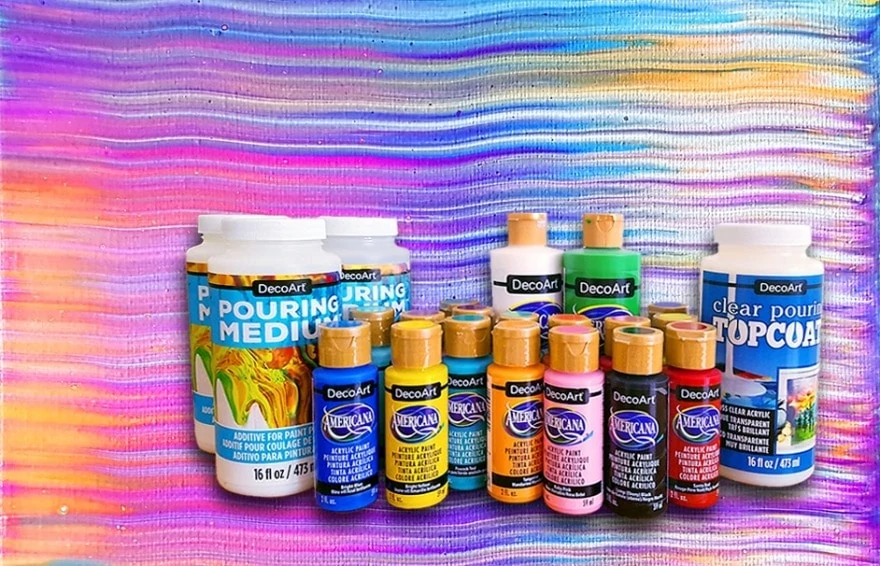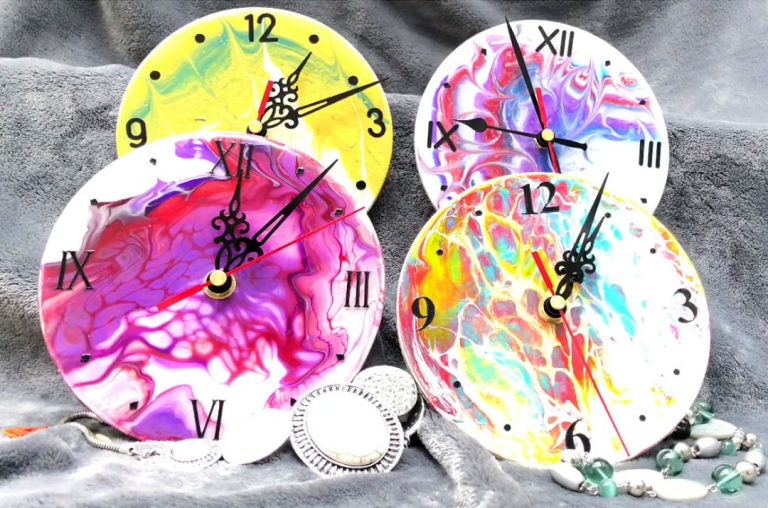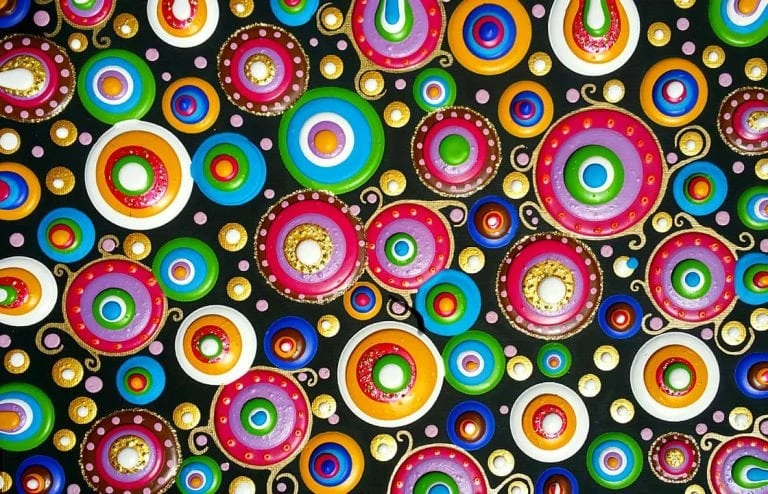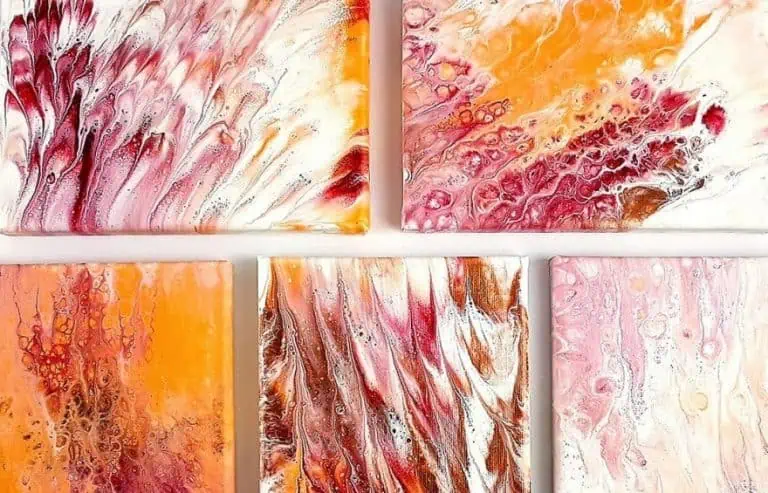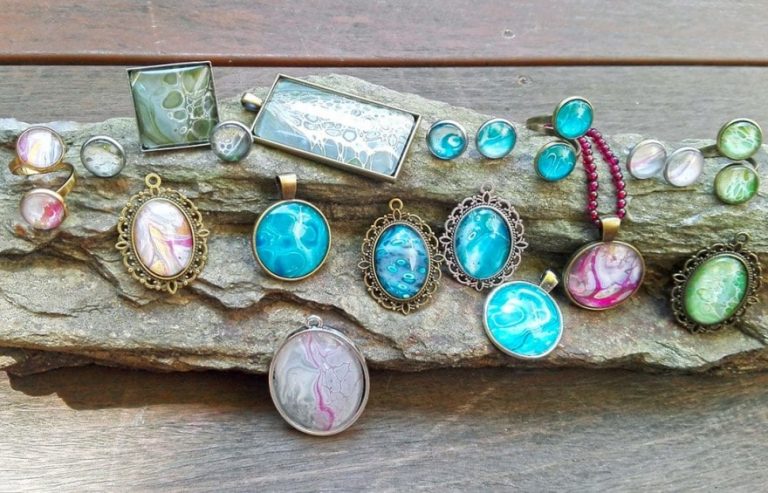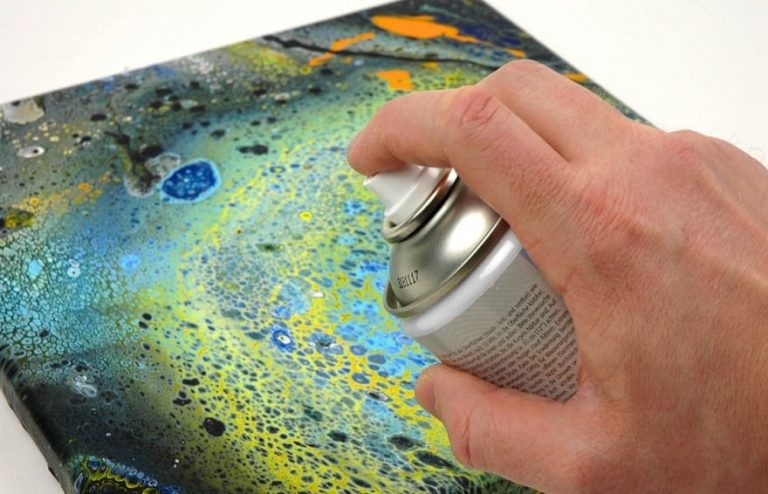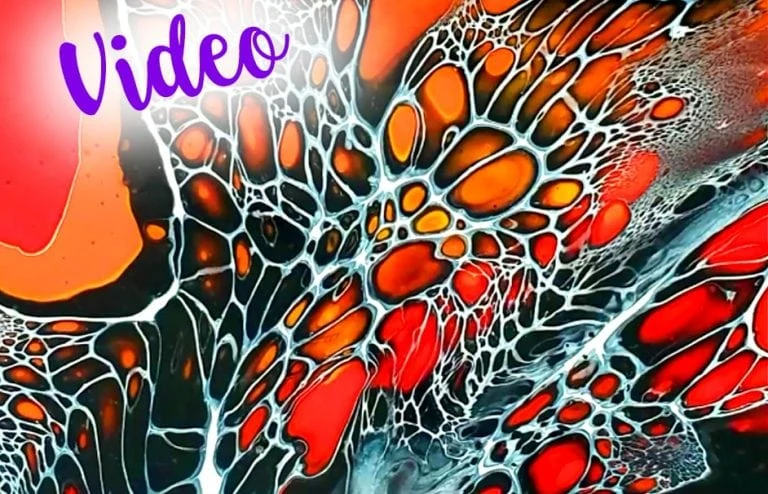Review: DecoArt Americana Acrylic Paint, Pouring Medium and Top Coat
This post may contain affiliate links. We may earn a small commission from purchases made through them, at no additional cost to you.
The company DecoArt offers a lot of products which are especially designed for Fluid Painting: The DecoArt Americana Acrylic Paint in countless, different shades, the DecoArt Pouring Medium and the DecoArt Clear Pouring Top Coat. But do these materials keep what DecoArt promises? I have thoroughly tested all products for you and show you what speaks for or against the DecoArt products.
Table of Contents
- 1 About DecoArt
- 2 Products I tested
- 3 About the Test Series
- 4 Test 1
- 5 Test 2
- 5.1 Mixing ratio 1 : 2 (paint : PM), no water addition, with silicone oil, FlipCup
- 5.2 Mixing ratio 1 : 2 (paint: PM), no addition of water, no silicone oil, FlipCup
- 5.3 Mixing ratio 1 : 1, 2mg each, with water addition, no silicone oil, Double Swipe
- 5.4 Mixing ratio 1 : 1, each 2 mg water addition, each 2 drops of silicone oil, Double Swipe
- 6 Test 3
- 7 Test 4: DecoArt Pouring Medium and Solo Goya Acrylic Paints
- 8 Test 5: DecoArt Acrylic Paint and Floetrol as Pouring Medium
- 9 Test 6: Top Coat
- 10 Final Conclusion
About DecoArt
DecoArt is an American company headquartered in Stanford, Kentucky and has been offering a wide and excellent range of colors and media in the medium price range since 1985.
The product range includes various acrylic paints, face and body paints, enamels, gesso and texture media, different varnishes, glitter, metallic and glass paints, brushes and accessories, stencils, chalks, outdoor paints, the company’s own pouring line and even DecoArt painting parties. The color selection and variety is wide and very appealing. Strong, bright colors speak for the high quality pigments and delight every artist’s heart.
On the bottle of the Pouring Medium the mixing ratio for the respective acrylic paints is indicated. The application recommendations of DecoArt are each without water and silicone additions and promise cell formation from the pouring medium alone.
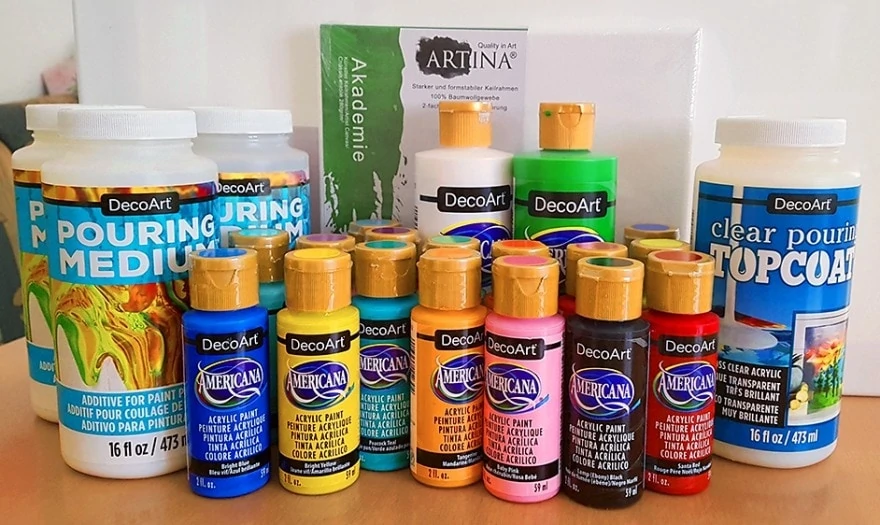
Products I tested
- Non-toxic and water-based
- Optimum consistency and matt finish
- Excellent pigmentation and coverage
- First-class non-yellowing pouring medium with ideal consistency
- Preserves the brilliance of the colors optimally
- Water-based, quick-drying, and flexible to prevent cracking and crazing
- Very good flow properties, does not yellow
- Dries to a perfect high gloss finish
- Specially designed for canvas and wooden painting surfaces
The following materials were also used for the tests
Artina Akademie Canvases
Solo Goya Acrylics
About the Test Series
All Acrylic Pouring Tests were carried out under the same temperature and time conditions, with the same amount of DecoArt paint to each other in the cup and the same drying conditions.
Test 1
Mixing ratio 1 : 1, no addition of water or silicone, various pouring techniques
I did the first test with the colors Festive Green, Snow White and Baby Blue. The paint could be mixed very well with the pouring medium. During normal stirring, no air bubbles at all were formed and even when mixed very quickly, very few bubbles were formed, but these dissolved quickly.
For this and all upcoming FlipCups I always layered the colors twice. The viscosity showed to be very good when stirring. After lifting the cup, the color could be distributed very well, but with hardly any cell formation. Remarkable is the very fast “skin formation”, i.e. after moving the picture the color solidifies relatively fast on the canvas. This hint can also be read on the bottle of the pouring medium and can be absolutely confirmed by me here. In contrast to other acrylic paints and media such as Floetrol or vinyl glue, I find this pouring medium to be the fastest in solidification. The total drying time of this mixture is about 1.5 days for the canvas size 15 x 15 cm depending on room temperature and humidity.
As there were no cells formed, I tried afterwards to create some cells on the freshly poured canvas with some mini-drops of silicone oil. Unfortunately, this was not possible with this medium. The silicone did not show any reaction and remained on the surface. When dried, many cracks and furrows appeared – especially in the places where I had dripped the silicone. Here it turned out that rather much paint should drip off the canvas or run down by tiling, because otherwise there is no nice surface. Also the short “opening time” of the medium plays a decisive role here.

With the same mixing ratio and the colors Santa Red, Bright Yellow, Bright Blue and Snow White I repeated this test but with the DirtyPour technique. After two coats I achieved a wonderful result – also concerning drying and surface. The brilliance of the DecoArt Paint is really very good and should be emphasized. So I can conclude that the Pouring Medium is very well suited for the DirtyCup. Also on the website of DecoArt this technique is shown in the tutorial videos. But also here (without addition of silicone) no cells have formed. Existing mini cells were small air inclusions which burst after the torching. But the result is still very good.
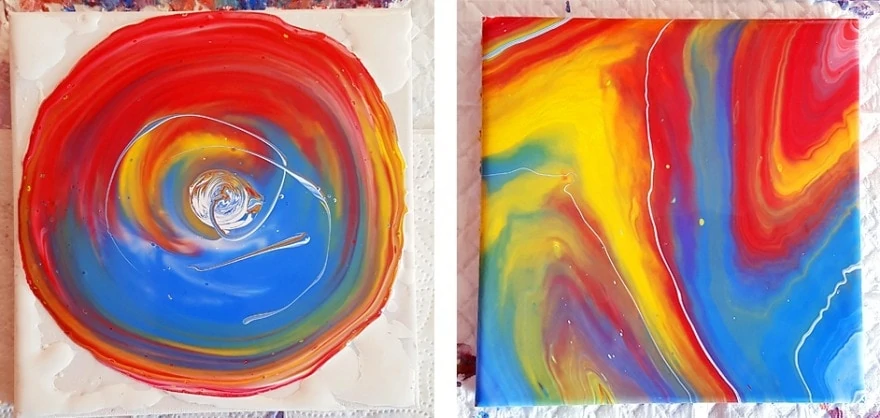
With the remaining colors I tried the dip technique: Very nice color reaction and brilliance without cell formation, as there is also no addition of silicone.

Test 2
Mixing ratio 1 : 2 (paint : PM), no water addition, with silicone oil, FlipCup
Here I have tested with the colors Festive Green, Brilliant Purple and Snow White, among others. The results showed again very good processing attributes: No blistering and fast, even mixing of color and medium, perfect in viscosity. A clear statement from DecoArt and for the artist a joy to use.
For this mixture, I added three “toothpick droplets” of silicone oil each directly before layering in purple and white. After lifting the cup, beautiful cells were formed and the paint could be spread very well on the canvas. After the torching there were more small beautiful cells, but here and there they got a little frayed with time. After approx. 2 days drying time, minimal holes have formed in the areas of the silicone oil, but these could be evened out well with the TopCoat Finish. The cells have retained their appearance even after drying. Therefore this result is a success.

Mixing ratio 1 : 2 (paint: PM), no addition of water, no silicone oil, FlipCup
With the colors Bright Blue, Baby Blue, Bahama Blue, Citron Green and Snow White I have now poured in the two coatings from far above. With this mixing ratio I am getting back more in the direction of perfect pour consistency and coverage. Unfortunately, also in this case the expected or promised cells have not formed. The cells on the picture were air bubbles, which I removed with the torch.

Interim Conclusion
The cell formation without silicone indicated on the pouring medium bottle could not be achieved or confirmed by me. With the addition of silicone in the usual sense, partly unsightly cracks and furrows were created. My recommendation here is to use less silicone than with the conventional media. Very beautiful stable cells I could reach with the WD 40, which is to be used however just as economically.
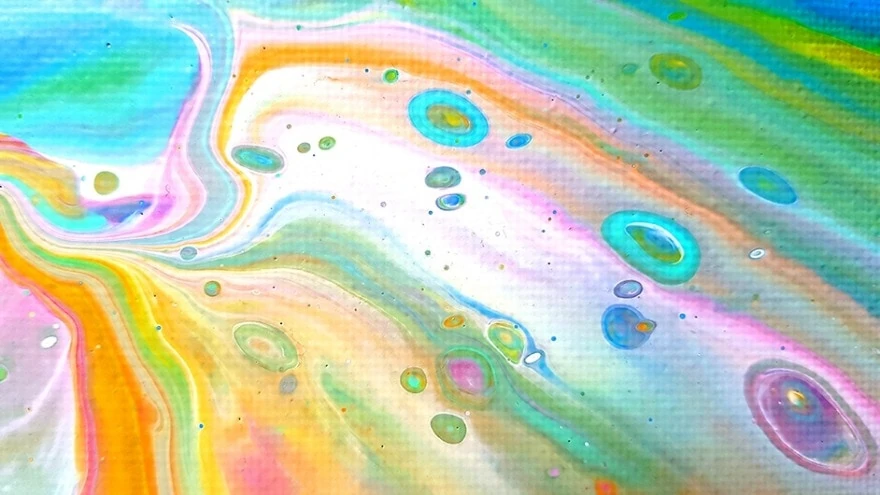
Mixing ratio 1 : 1, 2mg each, with water addition, no silicone oil, Double Swipe
For this test run I used the shades Snow White, Baby Pink, Tangerine, Brilliant Purple and Ocean Blue. I added water to all five paint mixtures. The water could be mixed in quickly and without bubbles. The Swipe could be done wonderfully and did not change when drying. The drying time here was about one day. But even here no cells were formed despite Torch.

Mixing ratio 1 : 1, each 2 mg water addition, each 2 drops of silicone oil, Double Swipe
The colors used here were Snow White, Bright Yellow, Boysenberry Pink and Orchid. With this mixture I could finally achieve wonderful cells and even after drying the picture hardly changed at all. Directly Swipes large cells came out. After the torching many small cells were formed additionally, which then increased in size over time. The surface has dried to an acceptable level. Nevertheless, in some places where there was a lot of silicone, small dents appeared again, but these are very negligible.
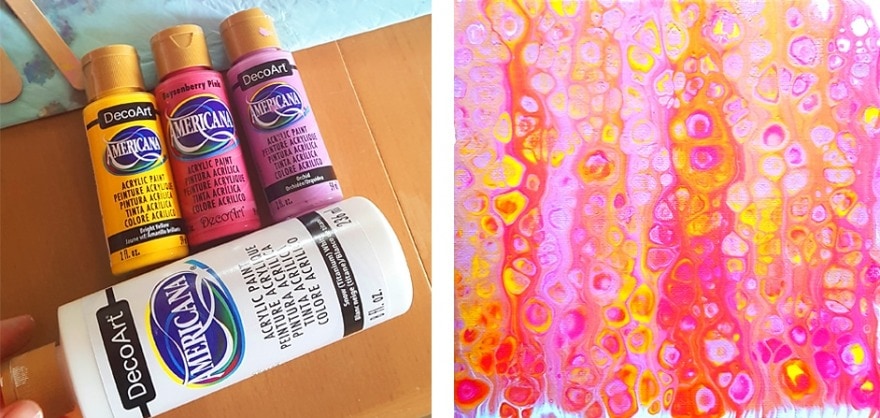
With the same mixing ratio and the colors Snow White and Festive Green I was able to achieve good cells. Here, however, I first poured white all over the picture, applied silicone oil with a toothpick, worked under the canvas again with a spatula, then poured the green at the edge and in the middle as a strip and did the Double Swipe. At the latest with the Torchen wonderful cells have shown up. Again, with the same drying time as described in the previous test run, great cells with a flawless surface were obtained.

Test 3
Mixing ratio 1 : 3 (Paint : PM), no addition of water, no silicone oil, FlipCup
Brilliant Purple, Festive Green and Bright Yellow were used, all in equal parts. In this experiment, the paint were of course very mixed – but also without cells. The drying time has been reduced to 1.5 days and the surface is very smooth and dried without blemishes. However, at the edges the canvas shines through in places. Therefore a rather transparent result can be expected with this mixing ratio.

Mixing ratio 1 : 3 (paint : PM), no water addition, with silicone oil, FlipCup
With the colors Snow White, Bright Yellow and Santa Red, all equally layered twice in the FlipCup, I was able to achieve cell formation again by adding silicone oil in white and yellow. However, these were again rather washed out and frayed, since this mixture ratio seems too thin for that. The picture has changed only minimally during drying (1.5 days) and has again places where the canvas shows through. In dry condition the silicone spots have cracks and furrows.

Test 4: DecoArt Pouring Medium and Solo Goya Acrylic Paints
Mixing ratio 1 : 1 (PM : paint), water addition as required, no silicone, FlipCup
The mixing (no blistering), consistency, mixing behavior and also the whole handling was almost the same with the Solo Goya colors Titanium White, Vermilion, Lemon and Primary Blue as with the DecoArt acrylic paint. Here it should be mentioned that the DecoArt colors do not smell at all in contrast to Solo Goya, which is to be evaluated extremely positively. The FlipCup was layered from a low height. Fortunately some cell formations could be observed already in the cup and then also on the canvas, which did not change when drying (approx. 1 day). The surface structure is good.

Mixing ratio 1 : 1 (PM : paint), water addition as required, no silicone, Double Swipe
Unfortunately I could not achieve any cell formation with the remaining colors in the Double Swipe technique. However, again the very good processing properties of the pouring medium and the fast skin formation should be mentioned.

Test 5: DecoArt Acrylic Paint and Floetrol as Pouring Medium
Mixing ratio 1 : 1 (Floetrol : paint), water addition as desired, no silicone, FlipCup
With the colors Citron Green, Ocean Blue, Peacock Teal, Sea Aqua and Snow White, large cells have formed without the addition of silicone, but these have changed slightly during drying. Here one clearly notices the longer “opening time” of the Floetrol in contrast to the DecoArt Pouring Medium.
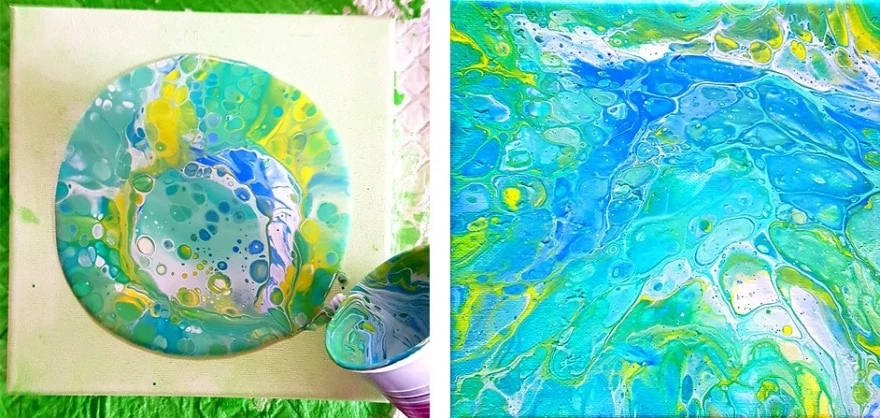
With the remaining colors I also tried the Double Swipe and could achieve beautiful fine cells.
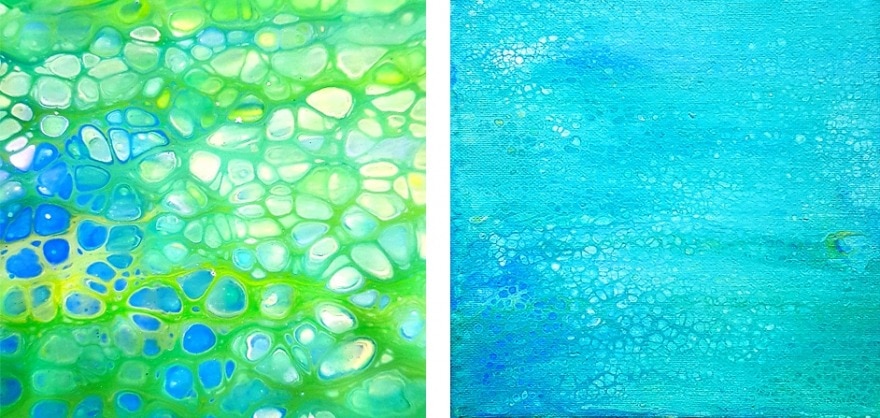
Test 6: Top Coat
The clear lacquer from DecoArt is also very easy to apply. As shown in the video from www.DecoArt.com I have poured the TopCoat over the pictures. The milky white liquid has no inherent odor and is rather thick. After pouring the TopCoat along the upper edge I moved the pictures until the whole surface was covered. In principle, the same handling as with a Pour: tilting until the canvas is covered.
Overnight the finish is almost completely dry and “shines” with perfect results. As the TopCoat is not really cheap in price, this is definitely compensated by the excellent result and the very easy handling. Since the varnish of pouring pictures (even for advanced painters!) can always be a challenge, the TopCoat is the best solution here. No brush strokes, dents, air inclusions, cracks or similar, but a crystal clear, clean surface gives every work of art the final perfect polish. Even without removing the silicone, the TopCoat has been shown to cover perfectly without repellent effects. It is comparable in appearance to a very thinly applied resin with a beautiful shine and is now my personal favorite for pouring pictures. Even small holes or cracks are beautifully smoothed out by this finish and even let them disappear.
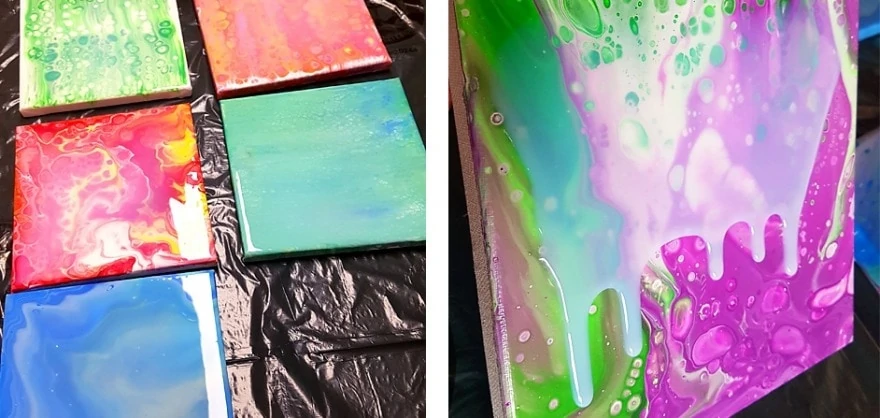
I poured along the edge as recommended by DecoArt, eradicated and poured again. Absolutely simple and perfect in the result.
Final Conclusion
With the products of DecoArt everyone can successfully start with acrylic casting. The medium price level is absolutely justified for the strong pigments in the DecoArt Acrylic Paint.
The DecoArt Pouring Medium can be processed very well and easily. The mixtures with the outstanding colors have proven to be very good in handling and consistency. After pouring, drying occurs very quickly and the picture does not drip for long.
Unfortunately I could not achieve the cell formation promised by DecoArt without silicone. Also the common addition of silicone with the Treadmill silicone oil had negative effects on the surface structure. WD 40 is better suited here.
It seems that DecoArt’s Pouring Medium contains hardly any silicone – in contrast to Floetrol, for example. The DecoArt medium clearly has the advantage of a short opening time and therefore the certainty that the picture will not change when drying. The control of the result is therefore given. If you want to cast without cells, this medium is very well advised anyway – especially for beginners. The high processing comfort is highly recommended for beginners. As with any medium, it is always important to find your own perfect consistency, depending on the desired end result, with a few attempts. However, these products guarantee quick success and wonderful results.
And with the DecoArt TopCoat Finish every picture becomes first class and rounds off the topping off with DecoArt media in perfection.
Have fun testing and enjoying yourself!
All tested products were provided to us by DecoArt, Inc. At this point we would like to thank you very much. However, this does not influence our opinion about the materials. Although we have conducted the tests as objectively as possible, this is of course still a personal opinion.
Learn more about DecoArt:
https://decoart.com
https://www.facebook.com/DecoArtAcrylicPaints
https://www.instagram.com/decoart/
https://www.pinterest.ch/decoart/
https://www.youtube.com/DecoArtpainter
Karin Zimmer lives in Baden-Württemberg, Germany. Already from childhood on she has been working as a craftswoman, artistic/creative and very close to nature. She likes to try out different painting and creative techniques again and again. The constant thirst for knowledge is her inner drive. After almost 20 years in the IT department of a bank as an administrator and coach, she now works independently as a wild herb pedagogue and freelance artist. She gives herbal tours, individual and group courses, and (intuitive) workshops in both areas. At the end of 2016, she discovered Acrylic and lets each of her paintings flow intuitively and with feeling. She sees her task in imparting knowledge and in triggering the pure joy of colors and structures in the viewer.
Learn more about Karin Zimmer.
